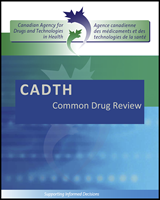1.1. Study Question
“From the perspective of the public payer in Canada, what is the cost-utility of Botox as compared to Best Supportive Care (BSC), for the prophylaxis of headache in adults who have failed three or more oral prophylactic medications?” (Page 7 of the Manufacturer’s Pharmacoeconomic [PE] report4)
To be in line with the requested indication, explicit reference to chronic migraine (CM) may have been more appropriate.
1.2. Treatment
OnabotulinumtoxinA is administered as a minimum of 31 and a maximum of 39 injections of five units (U) per injection (total: 155 U to 195 U) at sites on the neck and head every 12 weeks. A stopping rule has been proposed by the manufacturer.
1.3. Comparators
The manufacturer stated that BSC (defined as the use of acute medications as needed) was the comparator in this submission. This comparator was used in both the restricted and full patient populations. Although the manufacturer deemed this appropriately representative of the BSC population, the PREEMPT clinical trials did not include an active comparator arm (placebo). However, the manufacturer stated that “[onabotulinumtoxinA] would not replace any other headache prophylaxis therapy;” thus, the comparison appears to have been onabotulinumtoxinA + BSC versus placebo + BSC.
1.4. Type of Economic Evaluation
The manufacturer undertook a CUA. This is appropriate as per the Canadian Agency for Drugs and Technology in Health’s (CADTH’s) Guidelines for Economic Evaluations of Health Technologies: Canada.5
The analysis takes a public payer perspective. This is appropriate as per CADTH guidelines.5 A scenario analysis was conducted from the societal perspective.
1.5. Population
The HC indication for onabotulinumtoxinA is for prophylactic treatment of adults with CM (≥ 15 headache days per month [HDPM] with headache lasting four hours a day or longer). The manufacturer requested reimbursement of a subgroup of patients within the Health Canada (HC) indication — patients with CM who have failed three or more prior oral prophylactic medications.
As per CADTH Common Drug Review (CDR) guidance (CDR Update – Issue 83) the manufacturer included an analysis of the full CM population, as identified in the approved HC indication.
CDR clinical input has indicated that it is likely that onabotulinumtoxinA would only be considered for patients that had failed all other treatment types (including behavioural therapies).

